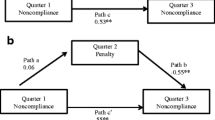Abstract
The siting of facilities with undesirable environmental characteristics often leads to public conflict. Efforts to resolve the conflict and make siting decisions frequently exacerbate the problem. Environmental mediation, the process of negotiating an agreeable settlement, is an accepted approach to resolving conflict. This paper explores the use of incentive systems as a means of achieving equity in environmental mediation. Obnoxious and noxious characteristics of facilities are discussed as the basis of conflicts. Four types of incentives—mitigation, compensation, reward, and participation—are discussed. The paper concludes with a discussion of the utility and application of incentives for solving environmental conflicts.
Similar content being viewed by others
Literature cited
Anderson, F., A. Kneese, P. Reed, S. Taylor, and R. Stevenson. 1977. Environmental improvement through economic incentives. Johns Hopkins Press, Baltimore. 195 pp.
Bjornstad, D., and E. Goss. 1982. Measuring the impacts of using payments in lieu of taxes to compensate communities when siting high-level nuclear waste respositories (draft). Oak Ridge National Laboratory, Oak Ridge, TN. 20 pp.
Carle, R. 1981. Why France went nuclear.Public Power July/August:58–85.
Carnes, S. 1982. Confronting complexity and uncertainty: implementation of hazardous-waste-management policy. Pages 33–50in Dean E. Mann, ed. Environmental policy implementation. Lexington Books, Lexington, MA.
Carnes, S., E. Copenhaver, J. Reed, J. Soderstrom, J. Sorensen, D. Bjornstad, and E. Peelle. 1982. Incentives and the siting of radioactive waste facilities (ORNL-5880). Oak Ridge National Laboratory, Oak Ridge, TN. 83 pp.
Copenhaver, E., S. Carnes, J. Soderstrom, J. Sorensen, D. Bjornstad, and E. Peelle. In press. A review of institutional and socio-economic issues for radioactive waste respository siting.In P. Hofman (ed.), Advances in the science and technology of the management of high-level radioactive waste. Battelle Institute, Columbus, OH.
Cormick, G. 1982. The myth, the reality, and the future of environmental mediation. Environment 24:15–39.
Cox, K., and D. Reynolds. 1974. Locational approaches to power and conflict. John Wiley and Sons, New York. 354 pp.
Dear, M., M. Taylor, and G. Hall. 1980. External effects of mental health facilities.Ann. Amer. Assoc. of Geogr. 70:342–352.
Ebbin, S., and R. Kasper. 1974. Citizen groups and the nuclear power controversy—uses of scientific and technological information. MIT Press, Cambridge, MA. 307 p.
Harvey, D. 1973. Social justice and the city. Edward Arnold, London. 336 pp.
Hodge, D., and A. Gatrell. 1976. Spatial constraint and the location of urban public facilities.Environ. and Planning 8:215–230.
Jannelle, D., and H. Millward. 1974. The intra-urban pattern of locational conflict.Proc. Assoc. Amer. Georg. 6:6–10.
Kevin, D. 1980. Federal state relations in radioactive waste management (draft). Office of Technology Assessment, Washington, DC. 88 pp.
Lake, L. 1980. Environmental mediation. Westview Press, Boulder, CO. 234 pp.
Ley, D., and J. Mercer. 1980. Locational conflict and the politics of consumption.Econ. Geogr. 56:89–109.
Moore, G., and R. Golledge. 1976. Environmental knowing. Dowden, Hutchinson and Ross, Stroudsburg, PA. 416 pp.
Morell, D., and C. Magorian. 1982. Siting hazardous waste facilities. Ballinger, Cambridge, MA. 266 pp.
National Governors' Association. 1981. Siting hazardous waste facilities. N.G.A., Washington, DC. 13 pp.
O'Hare, M. 1977. Not on my block you don't: facility siting and the strategic importance of compensation.Pub. Pol. Fall: 407–458.
Otway, H., and M. Fishbein. 1976. The determinants of attitude formation: an application to nuclear power. International Institute for Applied Systems Analysis, Laxemburg, Austria. 54 pp.
Popper, F. 1981. Siting LULU's.Planning April: 12–15.
Saarinen, T. 1976. Environmental planning: perception and behavior. Houghton-Mifflin, Boston. 288 pp.
Slovic, P., B. Fischhoff, and S. Lichtenstein. 1979. Rating the risks. Environment 21:14–39.
Smith, C., and R. Hanham. 1981. Any place but here! Mental health facilities as noxious neighbors.Prof. Geogr. 33:326–334.
Starr, C. 1980. Risk criteria for nuclear power plants: a pragmatic proposal. American Nuclear Society Conference paper, Washington, DC. 23 pp.
US Department of Energy. 1981. Final environmental impact statement solvent refined coal-II, Morgantown, West Virginia. US Department of Energy, Washington, DC. 236 pp.
Walker, R., and M. Heiman. 1981. Quite revolution for whom?Ann. Assoc. Amer. Geogr. 71:67–83.
Whyte, A. 1977. Guidelines for Field Studies in Environmental Perception. UNESCO, Paris. 117 pp.
Wilkinson, K., J. Thompson, R. Reynolds, L. Ostresh. 1982. Local social disruption and western energy development: a critical review.Pac. Soc. Rev. 25:275–296.
Wolpert, J. 1970. Departures from the usual environment in locational analysis.Ann. Assoc. Amer. Geog. 60:220–229.
Wolpert, J., A. Mumphrey, and J. Seley. 1972. Metropolitan neighborhoods: participation and conflict over change. Association of American Geographers, Washington, DC. 43 pp.
Author information
Authors and Affiliations
Rights and permissions
About this article
Cite this article
Sorensen, J.H., Soderstrom, J. & Carnes, S.A. Sweet for the sour: Incentives in environmental mediation. Environmental Management 8, 287–294 (1984). https://doi.org/10.1007/BF01868028
Issue Date:
DOI: https://doi.org/10.1007/BF01868028




